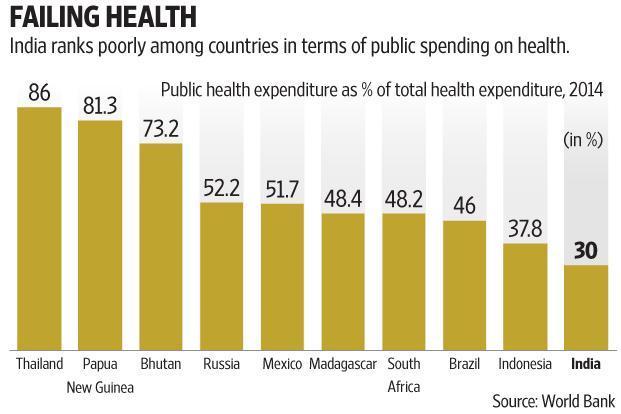(HOT) UPSC Current Affairs 2025 PDF
NEW! The Gist (NOV-2025) | E-BOOKS
Public Private Partnership (PPP) in Healthcare Sector : Important Topics for UPSC Exams

Public Private Partnership (PPP) in Healthcare Sector : Important Topics for UPSC Exams
Introduction
-
The highest attainable standard of health is a fundamental right of every human being. However, healthcare delivery poses a significant challenge for policymakers in India.
-
The news of overcharging by a private hospital for dengue treatment, despite not being able to save the patient's life, was met with an outrage.
Issues in Public Healthcare
-
Lack of resources such as 1:1,700, doctor:citizen ratio, well below the minimum ratio of 1:1,000 stipulated by WHO.
-
Rural areas and smaller towns of India are worst sufferer, where even basic health services remain inaccessible, many cases were reported where ward boy and alone found running the primary healthcare center.
-
Inadequate government spending on healthcare and lack of access to health insurance to large section of the society.
-
The quality of public health services in India continue to remain below expectations which hamper economic growth of the country.
-
Government's inability to build sufficient capacity and infrastructure, difficulty in reaching out to poor and vulnerable groups.
-
An undersized skilled workforce and the absence of upgraded technology is a major challenge in health sector.
Buy Printed Complete Study Materials for UPSC IAS PRELIMS Exam
Online Crash Course for UPSC PRE Exam

Need for PPP model in healthcare
-
To provide universal healthcare which is the need of hour given the dismal condition of healthcare sector in India
-
Its difficult for government alone to meet the healthcare infrastructure and capacity gaps in Tier II and Tier III cities as well as rural areas.
-
To provide Health insurance- Karnataka's Yeshasvini Cooperative Farmer's Healthcare Scheme and Andhra Pradesh's Arogya Raksha Scheme can be cited as successful examples.
-
The government's spending on healthcare is around 1.15% of its GDP which is very low .
-
As compared to their government counterparts private healthcare providers have done well in providing healthcare services
Issues in public private partnership
-
There lack of inbuilt mechanism to decide how the government and the private sector share revenue and risks.
-
Aim of Private sector is to maximize profit, which is inconsonance with governments aim of providing universal quality services to all
-
Lack of a proper regulatory framework to regulate the health sector and partnership.
-
Some PPP projects attempted earlier have failed, so there is apprehension about success of large scale PPP in health sector.
Way Forward
-
India needs a universal healthcare program that hinges on affordability and access.
-
PPP model as the way ahead is stressed by McKinsey, World Bank and the World Economic Forum but with clear policy guidelines to ensure the successful implementation of PPP models.
-
Independent regulators should be setup who can work independently without any political interference
-
The government should learn from successful experiences of different states and develop working guidelines based on it .
-
Public health spending must be raised to at least 2.5°/o of GDP.
-
Utilizing CSR spending for improving healthcare delivery can be of great help in improving the health care sector.
-
India must produce more doctors and nurses, whether for the public or private sector to improve healthcare delivery.
-
Karnataka government passed a law that would allow it to cap the rates of certain private healthcare services. More states need to follow the suit.
-
Policymakers must aim for convergence of commercial and social interests to make a large on-ground impact.
MODEL QUESTIONS
Civil Services preliminary examination
1. Consider the following statement about Pradhan Mantri Jan Aushadhi Yojana
-
It’s aim is to make quality medicines available at affordable prices for all, particularly the poor and disadvantaged, through exclusive outlets “Jan Aushadhi Medical Store”, so as to reduce out of pocket expenses in healthcare.
-
Bureau of Pharma PSUs of India (BPPI) is implementing agency of Pradhan Mantri Jan Aushadhi Yojana.
Which of the statement(s) is/are correct?
(a) Only 1
(b) Only 2
(c) Both 1 and 2
(d) Neither 1 nor 2
Correct answer: c
Civil Services Mains Examination

